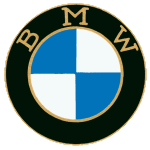www.bynumonline.com
Christian Bynum's Classic BMW Motorcycles: 1963 R50/2
Home > Motorcycles > BMW /2 > 1963 R50/2
 |
Motorcycle Data Sheet Model: 1965 BMW R50/2 (conversion) Nickname: "Schwarzi" (Der Schwarzer Wolf AKA the Black Wolf) Engine: 495cc 2-valve boxer twin converted to later 898cc (60 HP) Years of Production: 1960-1969 Number Produced: 19,036 Purchase Date: November 2003 Previous Location: Phoenix, AZ Previous Owners: Unknown Mileage at Purchase: 0 (Rebuilt) Mileage Since Engine Rebuild: 0 Restoration Projection: A lot... Restoration Costs to Date: $460 |
Background
My eventual goal for this /2 conversion bike, rebuilding a bare 1965 R50/2 frame with a later 1974 R90/6 engine and drivetrain, is to create a stylish yet practical sidecar outfit. up from a bare frame<, this motorcycle, which was sold to me on eBay as a frame only, stripped and ready for repainting and restoration, was my first foray into "vintage" Beemers, built during or before 1969 at the original Münich factory. This bike had started its life as a 1963 R50/2, a classic middle-displacement tourer of its day. I am rebuilding it as a "/2 conversion" using the '60s chassis with a '70s engine, electrical system, wheels, and other parts. When I first saw this /2 twin-loop frame, I already had many spare Airhead parts from my 70s bikes left over from my other ongoing motorcycle restorations, including a complete 600cc engine and a good /5 front end; a conversion seemed like a great way to use some of these spares and get in on the vintage bike mojo without the hefty front-end investment or the long-term maintenance hassle. There is a significant subset of the classic/vintage BMW motorcycle community interesed in discussing and performing these conversion projects.

Originally, I had sought out a /2 in the 1960-69 range as a conversion project for its strong frame, classic styling, cushy ride, and purpose-built standard sidecar lugs (on frames built between 1962 and 1967). I had wanted to make this bike haul a chair, a duty for which they are famous. However, I have since received some admonishments about putting a high-horsepower engine in a pre-1965 frame. The /2 frame was designed for three-wheeling, but not necessarily at modern highway speeds requiring maximum output from the classic boxer engine. While the frame itself is strong enough for sidecar duty, there are conflicting opinions as to how well the 1960-64 twin-loop-and-swingarm frames, which lack the extra strengthening gussets of their later counterparts, handle the vibration fatigue and torque stresses of engines that produce more than 40 HP. (Using a custom-designed swingarm that allows the use of a /5 or later final drive unit helps; these are among the priciest of the major components that get used in /2 conversion projects, but perhaps among the most worthwhile of expenditures that increase roadworthiness.) After bouncing queries off more learned motorcyclists, I finally settled on upgrading the stock 600cc /6 engine I had souced (with 40HP) with a slightly gutsier 800cc /7 top end with a lowered compression ratio, yeilding 25% more horsepower.
As the project evolved, I eventually decided on finding an Earles leading link fork for the front end, in place of the /5 telescopic fork I already had, a model essentially identical to the model fit to US-market /2s after 1967. The tradeoff is some loss of quickness in steering for a sublimely plush and compliant ride, which is fine by me for this motorcycle. Of course, once I bit the bullet to do this, the project became substantially less efficient (and substantially more involved). Instead of drawing on my store of spare /5 front end parts, I was scouring the Internet for a restorable swingarm front end with all of its own unique bits and pieces that were incompatible with the parts from the later telescopic fork. I could also no longer use my /5 front wheel, brakes, or fender, as /2 versions these components would likewise need to be located. (I took solace in the hope that the orphaned parts from this restoration would eventually find a home on my 1973 R75/5, a bare frameset just back from powdercoating at rest in my storage unit...)
When complete, I am confident that this bike will make a sporty, stylish city and highway mount with a lot of poise on the road...
Restoration
This motorcycle is essentially just lying in boxes in my storage unit and on the shelves in my home office. Here are the major components I have been able to source to date, including copious spares already on hand from my other projects:
- Frame
- 4.5-gallon gas tank with built-in keyed toolbox and alloy gas cap
- Upgraded 900cc /6 engine
- /5 four-speed transmission with kickstart and complete clutch/flywheel assembly
- Dyna III electronic ignition system
- Magura low sidecar handlebars and mounts
- /2 Earles leading link fork with complete shocks, headlight mounting ears, fender and stays
- /2 18" front wheel with hubcap
- /2 Earles fork front drum brakes with backing plate
- /2 centerstand
- /5 rear wheel with drum brakes, chrome hubcap, and axle
- Custom conversion swingarm
- 37/11 Airhead final drive
- Complete /2 wiring harness
- /5 chassis electrics
- Thunderchild diode board
- /5 switchgear and levers
- Reproduction bar-end turn signals
- Coffee can tail light
- /2 headlight bucket and new repro speedometer
- Steiger solo seat
- Hinged rear fender with stays
- OEM sport mufflers
- Enduro-style hard saddlebags (in desperate need of restoration)
After months of searching, in January 2004 I finally found a reasonably priced 18" /2 front wheel. Front shock cartridges for the Earles fork are next on my acquisition list; I want to retain as much of the /2's renowned plush ride as is feasible, so I am trying to source discounted new reproduction suspension components to reconstruct the front end. The Earles fork upper is being sent out to Vern Fueston at GT Enterprises in Montague, California for minor straightening and realignment. On the elective cosmetic front, I think a headlamp bikini fairing from www.omarsdtr.com Omar's Dirt Track Racing would complement nicely the bike's long, low, sporting lines and retro chic (as seen on the contemporary Yamaha cafe racer below).
BMW's Münich-built boxer twins had matching painted frames, tanks, and fenders. Although the vast majority of /2 bikes were the traditional black color with white pinstripes, for my conversion project I decided on restoring the motorcycle's frame and sheetmetal in something close to the factory's stellar optional paint color, Dover White, which looks like this:
I consulted Jim and the folks at Powdercoating Inc. in Mukilteo, Washington, and we came up with Tiger Drylac polyurethane color #9016 "Verkehrsweiß" ("Traffic White") as the closest match to coat the frame in a durable 90% gloss.


Charlie Moore at Tanks Only in Seattle was able to match this color for the tank and fenders. The repaired Earles fork will be likewise stripped and powdercoated to match the frame. The combined result should be fairly close to the original factory livery.
-->
Restoration
This motorcycle is essentially just lying in boxes in my garage. Here are the major components I have been able to source to date, including copious spares already on hand from my other projects:
- Frame
- 4.5-gallon gas tank with built-in keyed toolbox and alloy gas cap
- Upgraded 898cc R90/6 engine
- /5 four-speed transmission with kickstart and complete clutch/flywheel assembly
- Dyna III electronic ignition system
- Magura low sidecar handlebars and mounts
- /2 Earles leading link fork with complete shocks, headlight mounting ears, fender and stays
- /2 18" front wheel with hubcap
- /2 Earles fork front drum brakes with backing plate
- /2 centerstand
- /5 rear wheel with drum brakes, chrome hubcap, and axle
- Custom conversion swingarm
- 37/11 Airhead final drive
- Complete /2 wiring harness
- /5 chassis electrics
- Thunderchild diode board
- /5 switchgear and levers
- Reproduction bar-end turn signals
- Coffee can tail light
- /2 headlight bucket and new repro speedometer
- Steiger solo seat
- Hinged rear fender with stays
- Hella bar-end turn signals
- BSM 2-into-1 exhaust system (left-side exit model for sidecar use)
- OEM sport mufflers
- Enduro-style hard saddlebags (in desperate need of restoration)
Reconstruction Chronology
December 2003
- Performed touch-up sanding of beadblasted frame
- Powdercoated frame
- Had gas tank lined and painted with hand pinstriping
- Stripped/bead-blasted fork components
- Chased threads on frame and sanded powdercoat for electrical ground
- Installed steering head bearings
Acknowledgments
Thanks to the following individuals for assisting in this restoration project: Duane Ausherman, Barbara Bynum, Brock Downey, Virgil Elliott, Vern Fueston, David Makin, Charlie Moore, DL Powers, Jeff Roddick, Chuck Sherman, Bo Stewart, and Robert Valdez.





